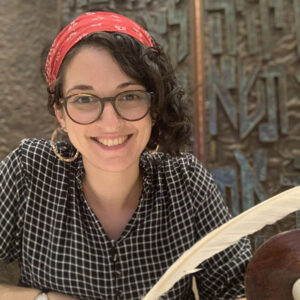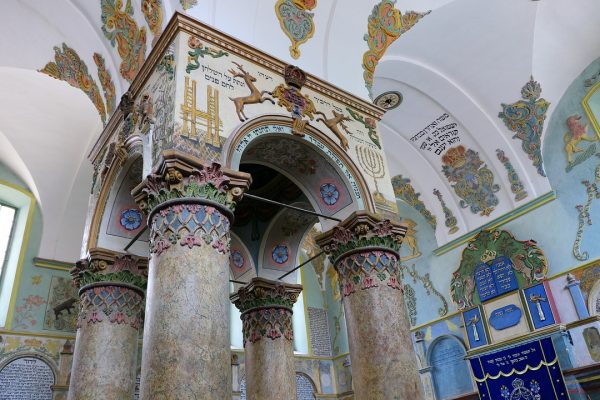As a soferet, a Torah scribe, I spend a lot of time with a feather and ink in my hand, writing new lines of text or repairing old and cracked letters in existing scrolls. On the surface, it may seem like the work of a scribe is rote and monotonous – she copies the same letters, the same words, the same stories over and over and over again. Indeed, part of my job is to ensure that each and every letter of a sacred text is written and maintained in its kosher form, that each and every word is spelled and ordered correctly. But what makes a sacred text sacred (like a Torah or mezuzah scroll) is not just about the letters and words that land on the page – it is actually dependent on the intention and focus of the scribe who brings ink to parchment.
Before beginning a writing project, a scribe must set an intention:
הֲרֵי אֲנִי כּוֹתֶבֶת לְשֵׁם קְדֻשַּׁת סֵפֶר תּוֹרָה, וְכָל שֵׁם הַשֵּׁם שֶׁאֲנִי כּוֹתֶבֶת אֲנִי כּוֹתֶבֶת לְשֵׁם קְדֻשַּׁת הַשֵּׁם
Behold, I am writing for the sake of the sanctity of the sefer Torah, and every name of God I write I write for the sake of the sanctity of God.
If a scribe doesn’t set this verbal, spoken, explicit intention before writing, the text is pasul, not kosher, unfit for ritual use.
But when you look at a completed text – be it a sefer Torah, a set of tefillin, a mezuzah klaf, or a megillah, there is no physical evidence of the scribe’s intention. But there it is, inked onto the page along with the letters, brushed up against the parchment, held in each and every stitch linking one yeriah – one page – to the next.
One of my beloved scribal arts teachers, Rabbi Dov Laimon, once shared with me that when he knows for whom he is writing tefillin or mezuzah klaf, he holds them in his mind as he writes. When I pass by the mezuzah in my house that holds the scroll Dov wrote for me, I feel the power not only of the mezuzah but of the connection to the scribe who held me in his heart as he wrote.
Before beginning a writing project or before repairing a scroll, I speak out my verbal intention. But then I often stay still for an extra moment. I think about what I want to bring to my writing or my repair. Sometimes, I think of an ancestor, sometimes I think of someone in need of healing, sometimes I think of a corner of the world that’s aching, and sometimes I think about the stories themselves and their reverberations in our living world. This practice keeps me focused and spiritually grounded as I write, connected to the letters and the words and the hands that will hold them. And, I like to think that somehow, that energy gets passed on along with the new or repaired letters.
“Inscribe us in the book of life” carries new meaning for me since becoming a scribe. When I hear and chant these words, I think of all the scribes whose hands have brought feather to parchment, all the stories of them and their loves. I think of all the hands that might learn to write the stories of our people, inking them over and over again. And I think of all the intentions and directed energy that each scribe held as they wrote, those thoughts buried in between the letters. Inscription is so much more than the words themselves; it is also about the way the words are written, the love and care that is poured into the process of writing. Inscription contains not only the narrative that ends up on the page but also the momentary pause that preceded that writing.
Scribing has taught me to pause to consider what I am carrying with me, who and what I am holding dear, before I engage in sacred work and ritual.
In this month of Elul, we take stock of where we are at this moment in our lives – what the year behind contained and what we long for in the one to come. The High Holiday season calls us to repair relationships and set priorities for ourselves and the relationships we hold dear. One of the added daily rituals during Elul intended to help us stay focused on the spiritual work of this season is the blast of the shofar each morning, rousing us from the routines we have fallen into, calling us to reorient ourselves and stay engaged in this heightened time of reflection and change.
If you don’t have a shofar or don’t have a space to hear the shofar daily this month, you can find recordings of Elul shofar blasts online. This year, I invite you to take a pause before hearing the sound of the shofar or sounding it yourself. In that moment of quiet, pause and consider what you are carrying with you, who or what you are holding dear. Like the pages of sacred text we read, the sound of the shofar will carry the resonance of all you are holding dear. Beneath the surface and in the echoes of the ringing blasts, perceptible or not, there lies that holding.
May the longings and yearnings and deepest desires on and within our hearts find their way into all we create now and in the year to come.
 Rabbi Bec Richman (she/her) is a mama, soferet, and potter who serves on the faculty of the Jewish Studio Project. In addition to scribing sacred texts, Bec facilitates scribal arts workshops and participatory Torah repairs across the country. Her pottery integrates hand-carved Hebrew lettering, and she creates custom ketubot with handwritten calligraphy. A graduate of the Reconstructionist Rabbinical College and an alumna of the Wexner Graduate Fellowship, Bec lives in Cleveland Heights, OH with her partner and kiddos. Bec’s artwork can be found at kotevetstudios.com.
Rabbi Bec Richman (she/her) is a mama, soferet, and potter who serves on the faculty of the Jewish Studio Project. In addition to scribing sacred texts, Bec facilitates scribal arts workshops and participatory Torah repairs across the country. Her pottery integrates hand-carved Hebrew lettering, and she creates custom ketubot with handwritten calligraphy. A graduate of the Reconstructionist Rabbinical College and an alumna of the Wexner Graduate Fellowship, Bec lives in Cleveland Heights, OH with her partner and kiddos. Bec’s artwork can be found at kotevetstudios.com. 












One Response
Thank you!